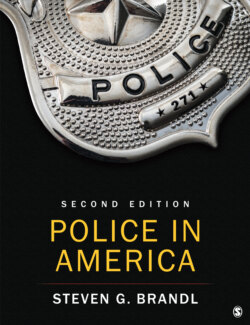Читать книгу Police in America - Steven G. Brandl - Страница 103
На сайте Литреса книга снята с продажи.
Technology on the Job
ОглавлениеPolice Department Size and Technology
As we have discussed, there are structural and personnel differences between large and small police departments. Interestingly, however, as seen in Table 3.1, there are relatively few differences between such departments in terms of the technology that is used by officers, especially video technology. The biggest differences are with body-worn cameras, which tend to be used more by smaller departments, and license plate readers and drones, which larger departments are more likely to deploy.
As such, it is not accurate to say that smaller departments are less advanced technologically than larger departments. However, as mentioned in the Police Spotlight feature at the introduction to the chapter, the local tax base and the amount of money available in communities for police services will strongly influence departmental operations, including the technologies available. The local tax base may or may not be associated with the size of the department.
Table 3.1
Source: Brian A. Reaves, Local Police Departments, 2013: Equipment and Technology (Washington, D.C.: Bureau of Justice Statistics, 2015).These figures represent the most current statistics available at the time of this writing.
The village of River Hills, Wisconsin, has a population of approximately 1,600 persons, and its police department has 11 sworn officers. The organization of the department is fairly typical for its size and is discussed here as an example of the structure of a very small department. It is organized into three patrol shifts and a support division. The department is led by a chief; sergeants are in command of each of the three patrol shifts. The sergeants report to the chief. A support staff (six clerks) are managed directly by the chief. In this jurisdiction, there are very few crimes (in 2017 there was one burglary and five thefts); investigations are conducted by patrol officers.
Description
Figure 3.3 River Hills, Wisconsin, Police Department Organizational Chart
Source: Author created.
Description
Figure 3.4 Watertown, Massachusetts, Police Department Organizational Chart16
Watertown, Massachusetts, is a suburb of Boston with a population of approximately 35,000. The Watertown Police Department has sixty-three sworn officers and thirteen civilians. These officers and civilian personnel work in various divisions within the department. The department is led by a chief and has two captains; one is responsible for managing the Bureau of Field Operations, and the other is responsible for the Bureau of Administrative Services. The Bureau of Field Operations oversees all things related directly to the patrol function of the department, including the patrol and traffic division. The Bureau of Administrative Services oversees the detective division and matters that relate to the internal functioning of the department, such as the operation of computer systems. Each division is led by a lieutenant. Internal affairs is directly under control of the chief of police.
Houston, Texas, has a population of approximately 2.3 million; it is the fourth-largest city in the country. The Houston Police Department has approximately 5,200 sworn officers. Due to the size of the city it serves, this department obviously looks quite different than the others discussed here. This is primarily because of the workload demands placed on the department and its corresponding size and specialization.
The Houston Police Department has a full staff with responsibilities that relate to the varied demands and workload of the agency. To provide for reasonable supervisory control, each functional unit of the department has its own supervisors and staff. Investigative and Special Operations and Field and Support Operations are the two sections of the department. Each of these sections is further divided by division (or “command”). Especially noteworthy is the specialization in criminal investigations and the units related to recruitment, training, and psychological services. Patrol is organized by geographic organization, with further divisions in each area, along with a patrol support division.
Description
Figure 3.5 Houston, Texas, Police Department Organizational Chart17
Source: https://www.houstontx.gov/police/organization/index.htm.
